| This article needs additional citations for verification. Please help improve this article by adding citations to reliable sources. Unsourced material may be challenged and removed. Find sources: "National Capitol of Cuba" – news · newspapers · books · scholar · JSTOR (July 2023) (Learn how and when to remove this message) |
| National Capitol of Cuba | |
|---|---|
| Capitolio Nacional de Cuba | |
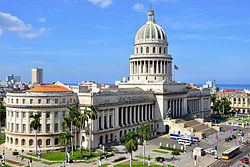 The National Capitol of Cuba from a rooftop to the southeast The National Capitol of Cuba from a rooftop to the southeast | |
| General information | |
| Town or city | Havana |
| Country | Cuba |
| Coordinates | 23°08′07″N 82°21′34″W / 23.13528°N 82.35944°W / 23.13528; -82.35944 |
| Construction started | 1 April 1926 |
| Completed | 20 May 1929 |

The National Capitol of Cuba, also known as Capitolio Nacional de La Habana (National Capitol of La Habana), and often simply referred to as El Capitolio (The Capitol), is a public edifice in Havana, the capital of Cuba. The building was commissioned by Cuban president Gerardo Machado and built from 1926 to 1929 under the direction of Eugenio Rayneri Piedra. It is located on the Paseo del Prado, Dragones, Industria, and San José streets in the exact center of Havana.
History


The Havana Capitol building was built on land that was a railroad terminal and used to belong to the Villanueva Railway. The project began in April 1926, during the Gerardo Machado administration. Construction was overseen by the U.S. firm of Purdy and Henderson. Prior to the Cuban Revolution of 1959, the Congress was housed in the building, the Congress was abolished and disbanded following the Cuban Revolution in 1959 and the building fell into disrepair.
"El Capitolio" is 207 meters long and 91 meters wide. Although its design is often compared to the United States Capitol, it is not a replica. "It is similar to that in Washington D.C, but a meter higher, a meter deeper and a meter longer, as well as much richer in detail. To finish its construction they needed more than 5000 workers, 3 years, 3 months and 20 days; as well as approximately 17 million American dollars". Completed in 1929, it was the tallest building in Havana until the 1950s. It houses the world's third largest indoor statue.
On August 30, 2019, the historian of the city Eusebio Leal proclaimed the end of the renovation with the unveiling of the dome.
Building


The cupola, which is stone-clad around a steel frame that was constructed in the United States, is set planimetrically forward on the building to allow for the apse that contains La Republica, the "Statue of the Republic". At almost 92 m (302 ft) high, the dome was the highest point in the city of Havana until 1956 when the FOCSA Building was built reaching a height of 121 meters (397 ft). The Capitolio had the third-highest dome in the world at the time of its construction. According to Eugenio Rayneri Piedra, the inspiration for the cupola came from the Panthéon in Paris by way of Bramante's Tempietto in San Pietro in Montorio.
The gardens, based on the designs of European gardens consisting of areas of lawn bordered by paths and highlighted by Royal Palm trees, were designed by French landscape architect Jean-Claude Nicolas Forestier who also designed the Paseo del Prado.
The 56 steps leading to the main entrance, La Escalinata, is flanked by 6.5 m (21 ft) statues by the Italian artist Angelo Zanelli. To the left is Work (El Trabajo) and to the right The Tutelary Virtue (La Virtud Tutelar). The steps lead up to the central portico, which is 36 m (118 ft) wide and more than 16 m (52+1⁄2 ft) tall. There are 12 granite columns in the ionic order arranged in two rows and each over 14 m (46 ft) tall. Beyond the portico, three large bronze doors with bas-reliefs by Zanelli allow access to the main hall.

The inside of the main hall under the cupola is the Statue of the Republic (La Estatua de la República).
The statue, also by Zanelli, was cast in bronze in Rome in three pieces and assembled inside the building after its arrival in Cuba. It is covered with 22 carat (92%) gold leaf and weighs 49 tons. At 15 m (49+1⁄4 ft) tall, it was the second highest statue under cover in the world at the time, with only the Great Buddha of Nara being taller. The statue stands on a plinth 2.5 m (8+1⁄4 ft) high bringing the total height to 17.54 m (57+1⁄2 ft). A Creole Cuban, Lily Valty served as the model for the body for Zanelli, and the inspiration for the statue came from Athena, the Greek goddess of wisdom.

Embedded in the floor in the center of the main hall is a replica 25 carat (5 g) diamond, which marks Kilometre Zero for Cuba. The original diamond, said to have belonged to Tsar Nicholas II of Russia and have been sold to the Cuban state by a Turkish merchant, was stolen on 25 March 1946 and mysteriously returned to the President, Ramón Grau San Martín, on 2 June 1947. To either side of the main hall is the Salón de Pasos Perdidos (Hall of Lost Steps), named for its acoustic properties. These halls, with inlaid marble floors and gilded lamps, lead to the two semicircular chambers that formerly housed the Parliament and Chamber of Deputies. The Parliament chamber to the right of the building is backed onto by the President's office which has a door opening directly onto the dais.
A range of different lamps is seen throughout the building. These were all designed specifically for the building by Cuban designers and the majority of them were manufactured in France.
In the center of the building are two patios which provide light and ventilation for the offices on the first (ground), third and fourth floors. The north patio features another statue The Rebellious Angel (El Ángel Rebelde) which was donated to the building after the inauguration. There is a small fifth floor and a sixth-floor which gives access only to part of the cupola.
Central portico
A wide granite staircase of 56 steps, 36 meters wide and 16 meters high, leads to the portico of the building. There are two rows of 6 columns of the Ionic order. The pillars stand out with a diameter of 1.55 meters and a height of 14.10 meters. Reasons for the hall, located in all the doors and the lateral panels, are the Boticcino marble squares sculpted by Angelo Zanelli.
On both sides of the end of the staircase are two bronze sculptural groups with granite pedestal by the Italian Angelo Zanelli, one male, and the other female, have a height of 6.70 meters and represent the first progress of human activity and the second the tutelary virtue of the people.
Statue of the Republic
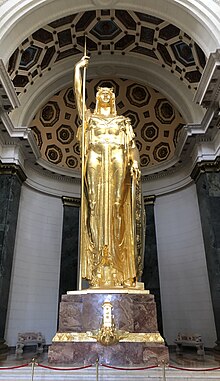
Located in the apse, the Statue of the Republic is the figure of a young woman standing, dressed in a tunic, with a helmet, shield and lance; it weighs 30 tons, is 14.60 meters high, and rests on a marble pedestal of 2.50 meters. It was sculpted by Angelo Zanelli, author of the Altare della Patria, part of the monument to King Victor Emmanuel II, in Rome. It is the third largest indoor statue in the world, surpassed only by the Buddha of Nara, Japan and the Abraham Lincoln statue in the Lincoln Memorial in Washington. D.C.
Gallery
-
 El Capitolio under construction in May 1929
El Capitolio under construction in May 1929
-
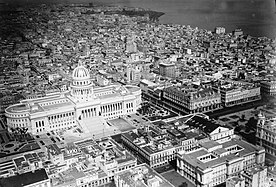 Aerial view (1940s)
Aerial view (1940s)
-
 La Cámara
La Cámara
-
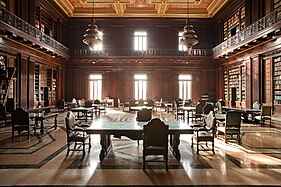 The library
The library
-
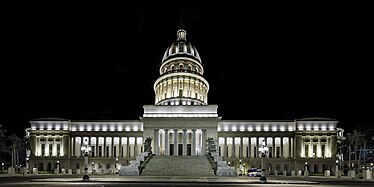 Eastern facade by night
Eastern facade by night
See also
References
General
- "El Capitolio de la Habana" (in Spanish). Convenciones Capitolio de La Habana. 2007. Archived from the original on 8 June 2007. Retrieved 3 May 2007.
- Rachel Carley (2000). Cuba: 400 Years of Architectural Heritage. Watson-Guptill. p. 224. ISBN 0-8230-1128-3.
- "Capitolio de La Habana" (in Spanish). Archived from the original on 3 June 2007. Retrieved 3 May 2007.
- Pedro Quiroga (1998). "El Capitolio: Un emporio en La Habana" (in Spanish). Radio Reloj, La Habana. Archived from the original on 9 May 2007. Retrieved 3 May 2007.
Cited
- "Historia del capitolio". www.capitolio.cu. Archived from the original on 26 August 2010. Retrieved 12 January 2022.
- "El Capitolio". Retrieved 2018-12-31.
- Iglesias Sánchez, Zenaida (19 January 2021). "La Estatua de la República" [The Statue of the Republic]. Habana Radio (in Spanish). Archived from the original on 23 April 2023. Retrieved 19 June 2024.
- "Termina la restauración de la cúpula del Capitolio Nacional" (in Spanish). 30 August 2019.
- "Ultimate Guide to Havana Cuba: Best Things to Do". Trip.com. 4 November 2019. Retrieved 19 June 2024.
- Quiroga, Pedro. "El Capitolio: Un emporio en La Habana" [The Capitol: An Emporium in Havana]. Cubaweb (in Spanish). Archived from the original on 7 April 2010. Retrieved 19 June 2024.
External links
- Construcción del Capitolio Nacional de La Habana 1929
- Cuba. Secretaría de Obras Públicas. Proyecto para la construcción de las Obras del Palacio del Congreso. Conjunto de Bocetos